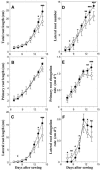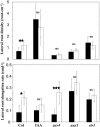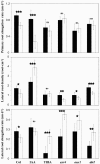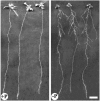A role for auxin redistribution in the responses of the root system architecture to phosphate starvation in Arabidopsis
- PMID: 16040660
- PMCID: PMC1183395
- DOI: 10.1104/pp.105.060061
A role for auxin redistribution in the responses of the root system architecture to phosphate starvation in Arabidopsis
Abstract
The changes in root system architecture (RSA) triggered by phosphate (P) deprivation were studied in Arabidopsis (Arabidopsis thaliana) plants grown for 14 d on 1 mM or 3 microM P. Two different temporal phases were observed in the response of RSA to low P. First, lateral root (LR) development was promoted between days 7 and 11 after germination, but, after day 11, all root growth parameters were negatively affected, leading to a general reduction of primary root (PR) and LR lengths and of LR density. Low P availability had contrasting effects on various stages of LR development, with a marked inhibition of primordia initiation but a strong stimulation of activation of the initiated primordia. The involvement of auxin signaling in these morphological changes was investigated in wild-type plants treated with indole-3-acetic acid or 2,3,5-triiodobenzoic acid and in axr4-1, aux1-7, and eir1-1 mutants. Most effects of low P on RSA were dramatically modified in the mutants or hormone-treated wild-type plants. This shows that auxin plays a major role in the P starvation-induced changes of root development. From these data, we hypothesize that several aspects of the RSA response to low P are triggered by local modifications of auxin concentration. A model is proposed that postulates that P starvation results in (1) an overaccumulation of auxin in the apex of the PR and in young LRs, (2) an overaccumulation of auxin or a change in sensitivity to auxin in the lateral primordia, and (3) a decrease in auxin concentration in the lateral primordia initiation zone of the PR and in old laterals. Measurements of local changes in auxin concentrations induced by low P, either by direct quantification or by biosensor expression pattern (DR5::beta-glucuronidase reporter gene), are in line with these hypotheses. Furthermore, the observation that low P availability mimicked the action of auxin in promoting LR development in the alf3 mutant confirmed that P starvation stimulates primordia emergence through increased accumulation of auxin or change in sensitivity to auxin in the primordia. Both the strong effect of 2,3,5-triiodobenzoic acid and the phenotype of the auxin-transport mutants (aux1, eir1) suggest that low P availability modifies local auxin concentrations within the root system through changes in auxin transport rather than auxin synthesis.
Figures












References
-
- Al-Ghazi Y, Muller B, Pinloche S, Tranbarger TJ, Nacry P, Rossignol M, Tardieu F, Doumas P (2003) Temporal response of Arabidopsis root architecture to phosphate starvation: evidence for the involvement of auxin signalling. Plant Cell Environ 26: 1053–1066
-
- Bates TR, Lynch JP (1996) Stimulation of root hair elongation in Arabidopsis thaliana by low phosphorus availability. Plant Cell Environ 19: 529–538
-
- Benkova E, Michniewicz M, Sauer M, Teichmann T, Seifertova D, Jurgens G, Friml J (2003) Local, efflux-dependent auxin gradients as a common module for plant organ formation. Cell 115: 591–602 - PubMed
-
- Bhalerao RP, Eklof J, Ljung K, Marchant A, Bennett M, Sandberg G (2002) Shoot-derived auxin is essential for early lateral root emergence in Arabidopsis seedlings. Plant J 29: 325–332 - PubMed
-
- Blakely LM, Durham M, Evans TA, Blakely RM (1982) Experimental studies on lateral root formation in radish seedlings roots. 1. General methods, developmental stages and spontaneous formation of laterals. Bot Gaz 143: 341–352
Publication types
MeSH terms
Substances
LinkOut - more resources
Full Text Sources
Other Literature Sources
Molecular Biology Databases
Research Materials
Miscellaneous

